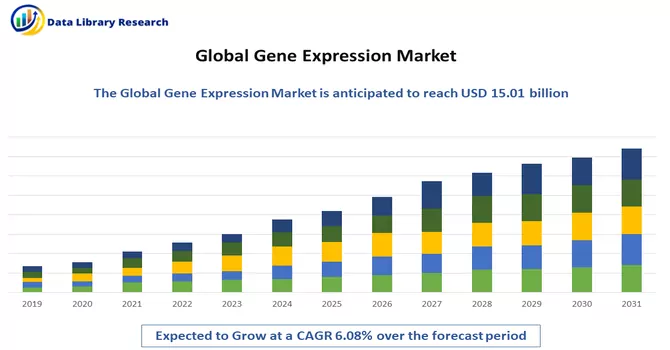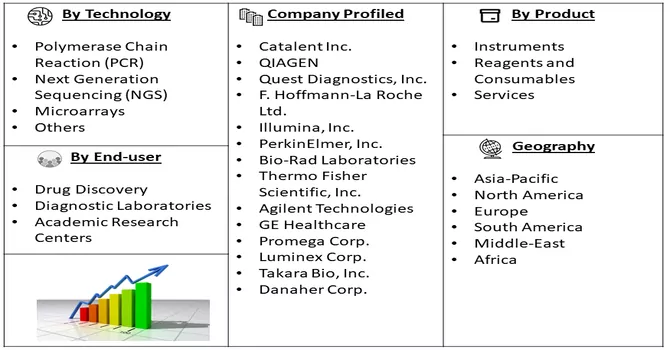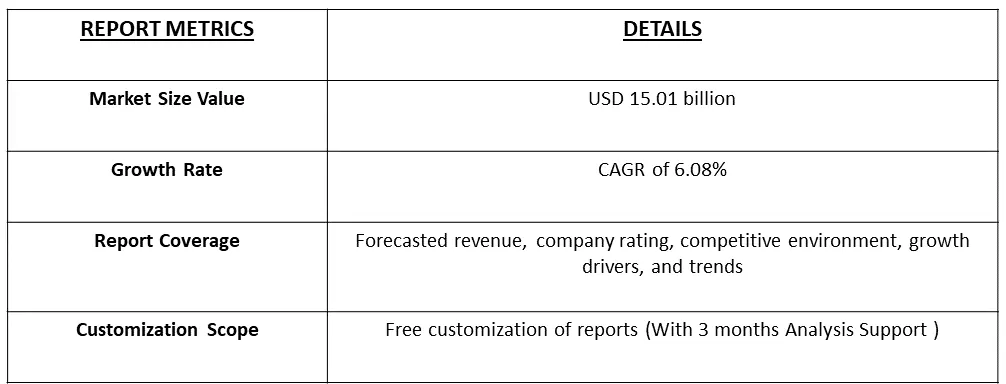As of 2022, the global gene expression market reached a valuation of USD 15.01 billion, with a projected compound annual growth rate (CAGR) of 6.08% over the forecast period from 2023 to 2030.

Get Complete Analysis Of The Report - Download Free Sample PDF
The Gene Expression Analysis Industry encompasses the study of how genes operate and interact within cells, tissues, or organisms by analyzing gene expression levels. This involves measuring the activity of genes at the RNA or protein level, offering insights into biological processes, diseases, drug responses, and various cellular functions. Gene expression analysis holds a crucial role in biomedical research, aiding scientists in comprehending disease mechanisms, identifying biomarkers, exploring potential drug targets, and advancing personalized medicine. The field has experienced accelerated growth due to advancements in research techniques, including microarrays, next-generation sequencing (NGS), and quantitative PCR, elevating the significance of gene expression analysis in scientific exploration.
Key drivers propelling market growth include advancements in genomics, the surging demand for personalized medicine, and the increasing prevalence of chronic diseases such as cardiovascular diseases, cancer, and neurological disorders. For instance, cancer is characterized by altered gene expression, where the activation or silencing of specific proteins significantly impacts cellular activity. The modulation of gene expression becomes essential in activating or increasing the expression of certain genes that may not typically be expressed in a specific cell.
An emerging trend in gene expression studies is the increasing adoption of single-cell analysis techniques. This approach empowers researchers to deconstruct cellular heterogeneity and gain insights into gene expression profiles at the individual cell level. Single-cell analysis facilitates the identification of rare cell populations, offers a nuanced understanding of cellular dynamics, and contributes to unraveling complex biological processes. Researchers are progressively integrating gene expression analysis with other omics technologies, including genomics, proteomics, metabolomics, and epigenomics. This integration of diverse biological information layers provides a more holistic perspective on cellular mechanisms, disease pathways, and the intricate interactions among various biological molecules.
Market Segmentation: The Gene Expression Analysis Market is segmented by Technology (Polymerase Chain Reaction (PCR), Next Generation Sequencing (NGS), Microarrays, and Others), Product (Instruments, Reagents and Consumables, and Services), End-user (Drug Discovery, Diagnostic Laboratories, and Academic Research Centers), and Geography (North America, Europe, Asia-Pacific, Middle East & Africa, and South America). The report offers the value (in USD million) for the above segments.

For Detailed Market Segmentation - Download Free Sample PDF
Market Drivers:
Technological Innovations
Ongoing technological advancements, including high-throughput sequencing, single-cell analysis, and bioinformatics tools, have brought about a revolutionary transformation in gene expression analysis. These innovations have significantly enhanced the speed, precision, and cost-effectiveness of gene expression profiling, democratizing access for both researchers and clinicians. As an illustration, in September 2022, Illumina, Inc., a global leader in DNA sequencing and array-based technologies, introduced NovaSeq, a new line of production-scale sequencers that push the boundaries of what is achievable in genomic medicine. NovaSeq X Plus, powered by groundbreaking technology, has the capability to generate over 20,000 whole genomes annually, representing a 2.5-fold increase in throughput compared to earlier sequencers. This substantial enhancement in sequencing capabilities contributes significantly to genomic discovery and clinical insights, advancing our understanding of diseases and ultimately impacting patient lives. Such advancements play a pivotal role in propelling the growth of the studied market over the forecast period.
Diagnostic Applications
In diagnostics, gene expression analysis plays a pivotal role, particularly in the identification and monitoring of diseases such as cancer. Biomarkers derived from gene expression patterns contribute significantly to early detection, prognosis assessment, and monitoring treatment responses, thereby enhancing clinical decision-making. Notably, in January 2023, QIAGEN Digital Insights (QDI) introduced the QIAGEN CLC Genomics Workbench Premium to address challenges associated with the data analysis bottleneck in next-generation sequencing (NGS). This premium tool seamlessly integrates high-speed analysis with the interpretation of data from diverse sequencing approaches, including whole exome sequencing (WES), whole genome sequencing (WGS), and large panel sequencing, effectively addressing the NGS data analysis bottleneck.
Market Restraints:
Complex Data Analysis and Interpretation High Costs and Infrastructure Requirements
While advancements in technology generate vast amounts of data, the analysis and interpretation of this data pose significant challenges. Gene expression analysis often involves complex data sets that require sophisticated bioinformatics tools and expertise to extract meaningful insights. The complexity of data analysis can hinder researchers who lack the necessary computational skills or access to specialized software. The initial costs associated with gene expression analysis technologies, such as next-generation sequencing platforms or high-throughput assays, can be substantial. Additionally, maintaining and operating these instruments along with the costs of consumables and reagents can pose a financial barrier, particularly for smaller research laboratories or institutions with limited budgets. Thus, such factors are slowing down the growth of the studied market over the forecast period.
Laboratories and research facilities faced closures or limitations on operations due to lockdowns and social distancing measures. This disrupted ongoing gene expression analysis studies, leading to delays in experiments, data collection, and collaborative research efforts. The gene expression analysis industry relies on a global supply chain for equipment, reagents, and consumables. The pandemic-induced disruptions in manufacturing, shipping, and distribution affected the availability of essential laboratory supplies, leading to delays and shortages, hindering research activities. A rise in the analysis of gene expression profiles of SARS-CoV-2 receptors for in silico drug discovery for COVID-19 is a high-impact rendering driver for the segment. For instance, according to an article published in the Antibiotics journal, in March 2022, titled " The Impact of Multiplex PCR in Diagnosing and Managing Bacterial Infections in COVID-19 Patients Self-Medicated with Antibiotics', multiplex polymerase chain reaction (PCR), a powerful and efficient tool, is used to diagnose SARS-CoV-2 infections and that has applications for bacterial identification, as well as determining bacterial resistance to antibiotics. Additionally, a study published in the Frontiers in Genetics publications in May 2022 stated that in COVID-19 patients, the gene profiling and analysis of certain common differentially expressed genes (co-DEGs) could be used for the diagnosis and management of the thrombosis and anticoagulant therapy in the COVID-19 patients. The gene expression analysis of the co-DEGs, along with their biological potential functions, protein-protein interactions, functional enrichment analysis, and study of their molecular mechanisms. Thus, the COVID-19 pandemic is leading to an increased demand for gene expression analysis for detecting coronavirus infection among the population. Thus, the COVID-19 pandemic is leading to an increased demand for gene expression analysis for detecting coronavirus infection among the population.
Segmentation Analysis:
Polymerase Chain Reaction Segment is Expected to Witness Significant Growth Over the Forecast Period
PCR is a variation of PCR that allows for the quantification of gene expression levels. It measures the amount of amplified DNA product in real-time as the reaction progresses. This technique is used to accurately measure the expression levels of specific genes and analyze changes in gene expression under different experimental conditions, disease states, or treatments. It's widely used in research and diagnostics to validate gene expression data obtained from other methods.
Most of the opportunities provided in the market are due to an increasing need for the personalized type of medicines. In order to detect a disease the technology which will be able to gain information at the molecular base will be extremely beneficial. Polymerized chain reaction techniques are used on a large scale for all the screening methods. The biotechnology industry has gained traction due to the introduction of the polymerase chain reaction. Polymerase chain reaction is an important part of the life sciences as well as the pharmaceutical industry. As the devices are used on large scale for the discovering of the drugs the demand for the polymerase chain reaction technology is expected to grow well in the coming years.
An RT PCR test was launched in the year 2021 for the testing of the COVID-19 virus by PathStore which was offered at the lowest price in comparison to the test kits provided by other companies. The introduction of this product will be helpful in maximizing the diagnosis of the virus for ensuring early treatment. Thus, owing to such developments the segment is expected to witness significant growth over the forecast period.
Drug Discovery Segment is Expected to Witness Significant Growth Over the Forecast Period
Drug discovery is undergoing a transformative phase, propelled by advancements in gene expression analysis. The integration of cutting-edge technologies such as high-throughput sequencing, single-cell analysis, and bioinformatics tools has revolutionized the understanding of gene expression patterns, enabling a more nuanced approach to identifying therapeutic targets. Researchers and pharmaceutical companies are increasingly leveraging these tools to unravel the intricate molecular mechanisms underlying diseases, paving the way for the development of precision medicines. For instance, recent launches of advanced real-time PCR systems, like Bio-Rad Laboratories' CFX Duet, showcase the industry's commitment to enhancing gene expression analysis capabilities. The synergy between drug discovery and gene expression analysis not only expedites the identification of potential drug targets but also facilitates the development of more effective and targeted therapies, marking a pivotal era in the evolution of pharmaceutical research and personalized medicine.
North America Region is Expected to Witness Significant Growth Over the Forecast Period
The region boasts a robust and well-established infrastructure for biomedical research, including top-tier universities, research institutions, and biotechnology companies. This environment fosters innovation and technological advancements in gene expression analysis.
Furthermore, the increasing emphasis of companies on research and development endeavors aimed at the development of gene therapy products and methods involving gene expression analysis, coupled with a growing adoption of diverse business strategies such as product launches, partnerships, collaborations, and acquisitions, is fostering market growth. A notable example is Bio-Rad Laboratories, Inc., which, in May 2022, introduced the CFX Duet Real-Time PCR System. This system facilitates singleplex and duplex quantitative PCR (qPCR) assays, enabling multiple gene expression analyses and precise quantification analysis of up to two targets in genotyping without the use of dye. In a similar vein, in December 2021, Microbix Biosystems expanded its range of Quality Assessment Products ('QAPsTM') by launching a single-unit swab-formatted control that supports PCR tests for SARS-CoV-2 ('COVID'), Influenza A ('Flu A'), Influenza B ('Flu B'), and Respiratory Syncytial Virus ('RSV')—four of the most prevalent causes of viral infectious respiratory infections globally. Such initiatives are expected to drive increased demand for gene expression analysis, thereby contributing to the overall market growth.
Likewise, in November 2021, Regeneron Pharmaceuticals extended the research term of its strategic partnership with Decibel Therapeutics to explore and develop gene therapies for hearing loss. These strategic moves collectively indicate a trend towards advancements in gene therapy and expression analysis, underscoring the anticipation of substantial market growth over the forecast period in the region.

Get Complete Analysis Of The Report - Download Free Sample PDF
The market studied is moderately consolidated, owing to the presence of many small and large market players. The key players are adopting different growth strategies to enhance their market presence, such as partnerships, agreements, collaborations, new product launches, geographical expansions, mergers, and acquisitions. Regional and service portfolio expansions and mergers and acquisitions are key strategic undertakings adopted by these players. Some prominent players in the gene expression market are:
Recent Developments:
1) January 2023: QIAGEN Digital Insights (QDI), the bioinformatics business of QIAGEN, launched its QIAGEN CLC Genomics Workbench Premium, which removes the data-analysis bottleneck of next-generation sequencing. The bottleneck of the NGS data analysis is offered by adding high analysis speed to the analysis and interpretation of the whole exome sequencing (WES), whole genome sequencing (WGS), and large panel sequencing data.
2) October 2022: Kite, a Gilead Company, signed an exclusive worldwide license agreement with Refuge Biotechnologies, Inc. Under the agreement, Refuge's proprietary gene expression platform would be utilized for the development of blood cancer therapy. The Refuge's proprietary gene expression platform consists of an expression modulation strategy that represses or activates the target genes' transcription, which has been found helpful in CAR T (chimeric antigen receptor T)-cell therapy.
3) March 2022: The University of Mississippi Medical Center set up clinical next-generation sequencing (NGS) machine, a first-in-the-state resource. It allows physicians to assess the DNA sample from cancer patients faster and more cost-efficient.
Q1. What was the Gene Expression Market size in 2022?
As per Data Library Research the global gene expression market reached a valuation of USD 15.01 billion in 2022.
Q2. At what CAGR is the Gene Expression Market projected to grow within the forecast period?
Gene Expression Market is projected compound annual growth rate (CAGR) of 6.08% over the forecast period.
Q3. What are the factors driving the Gene Expression Market?
Key factors that are driving the growth include the Technological Innovations and Diagnostic Applications.
Q4. Which region has the largest share of the Gene Expression Market? What are the largest region's market size and growth rate?
North America has the largest share of the market. For detailed insights on the largest region's market size and growth rate request a sample here.
Data Library Research are conducted by industry experts who offer insight on industry structure, market segmentations technology assessment and competitive landscape (CL), and penetration, as well as on emerging trends. Their analysis is based on primary interviews (~ 80%) and secondary research (~ 20%) as well as years of professional expertise in their respective industries. Adding to this, by analysing historical trends and current market positions, our analysts predict where the market will be headed for the next five years. Furthermore, the varying trends of segment & categories geographically presented are also studied and the estimated based on the primary & secondary research.
In this particular report from the supply side Data Library Research has conducted primary surveys (interviews) with the key level executives (VP, CEO’s, Marketing Director, Business Development Manager and SOFT) of the companies that active & prominent as well as the midsized organization
FIGURE 1: DLR RESEARH PROCESS

Extensive primary research was conducted to gain a deeper insight of the market and industry performance. The analysis is based on both primary and secondary research as well as years of professional expertise in the respective industries.
In addition to analysing current and historical trends, our analysts predict where the market is headed over the next five years.
It varies by segment for these categories geographically presented in the list of market tables. Speaking about this particular report we have conducted primary surveys (interviews) with the key level executives (VP, CEO’s, Marketing Director, Business Development Manager and many more) of the major players active in the market.
Secondary ResearchSecondary research was mainly used to collect and identify information useful for the extensive, technical, market-oriented, and Friend’s study of the Global Extra Neutral Alcohol. It was also used to obtain key information about major players, market classification and segmentation according to the industry trends, geographical markets, and developments related to the market and technology perspectives. For this study, analysts have gathered information from various credible sources, such as annual reports, sec filings, journals, white papers, SOFT presentations, and company web sites.
Market Size EstimationBoth, top-down and bottom-up approaches were used to estimate and validate the size of the Global market and to estimate the size of various other dependent submarkets in the overall Extra Neutral Alcohol. The key players in the market were identified through secondary research and their market contributions in the respective geographies were determined through primary and secondary research.
Forecast Model
